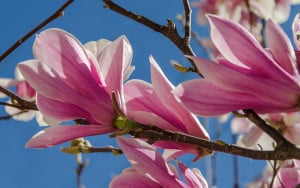Magnolias are beautiful plants and easily identifiable by their fascinating goblet or star-shaped flowers that bloom in spring and summer. There are an abundance of magnolias to grow in the garden, so find out more about them and how to grow them best.
Magnificent magnolias
Depending on the type, magnolias can grow up to 2 to 15m tall, with a spread between 3-10m. They tend to grow best in full sun or partial shade in a sheltered spot, and prefer a soil that is neutral or slightly acidic.
Therefore, it’s best to use a potting compost that is perfect for ericaceous plants. Fortunately, there are smaller magnolias that grow well in containers, so if you don’t have acidic soil, they can still be successfully grown in a pot.

In addition, magnolias are generally hardy, but they protection from frost will ensure the flowers aren’t damaged in spring.
Plant pollination

Interestingly, magnolias are ancient trees and evolved very early, they are considered to be one of the oldest flowering plants.
However, whilst magnolias were evolving, pollinators such as bees, butterflies and moths hadn’t quite, so pollination of the plants was done by beetles and flies instead.
Therefore, the structure of the plants was suited to those pollinators.
For example, the mouthparts of beetles are suited for chewing rather than delicately collecting pollen.
So, when they are harvesting pollen from the plant, other areas were eaten at the same time. For this reason, magnolia flowers have thick, leathery leaves and seeds that can handle this.
Planting and pruning
Magnolias are best planted in autumn or late spring. When planting, a deep hole isn’t necessary as they have quite shallow root systems. Instead, dig a hole the same depth as the container it comes in.
Once it’s in the ground, surround it with plenty of organic matter such as well-rotted garden compost or lead mould. Then, the ground can be firmed and watered well to help it establish.

Pruning differs for different types. However, generally they don’t tolerate hard pruning very well. Instead, prune once flowering to remove any dead, damaged, or diseased wood.
Hard pruning of deciduous magnolias can encourage long shoots called watershoots to grow. However, for evergreen magnolias that are well established, you can hard prune if necessary – such as after a storm to remove any dead or damaged wood.
For wall-trained magnolias, a light prune can be done in summer, or if free standing then a light prune in spring.
Magnolias to try
Magnolia stellata (star magnolia)
As its name suggests, this magnolia has white, star shaped flowers that bloom in spring. The pure white flowers make great cut flowers, but when growing in the garden they can grow well in containers, so perfect for smaller gardens or courtyard and city spaces.
- Flowers in spring
- Fully hardy
- Grows to 2.5m tall and 4m wide
- Moist but well-drained or well-drained soil
- Full sun or partial shade
- Sheltered

Magnolia ‘Apollo’
Next is a wonderful tree that has star shaped flowers that are deep purple on the outside, fading to pale pink at the centre. Growing to 6m tall, these ornamental trees are a great for low maintenance gardens.
- Flowers in spring
- Hardy
- Grows to 6m tall and 8m wide
- Moist but well-drained
- Full sun or partial shade
- Sheltered
Magnolia sieboldii subsp. sinensis (Chinese magnolia)
Alternatively, for larger gardens, the Chinese magnolia grows up to 8m tall and wider than 8m, taking 20-50 years to grow to its ultimate height. The dark green leaves contrast wonderfully with the white cup-shaped flowers that are fragrant.
- Flowers in spring and summer
- Fully hardy
- Grows to 8m tall and wider than 8m
- Moist but well-drained or well-drained
- Full sun or partial shade
- Sheltered

Magnolia liliiflora (black lily magnolia) ‘Nigra’
The dark, dramatic colour flowers are tulip-shaped with red-purple colouring that bloom in summer, joining the shrub’s glossy green leaves. In a sheltered spot with acidic or neutral soil, this plant will grow happily.
- Flowers in summer
- Fully hardy
- Grows to 4m tall and 2.5m wide
- Moist but well-drained or well-drained
- Full sun or partial shade
- Sheltered


Leave A Comment